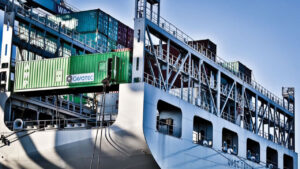A prototype of the world’s first class-approved ship propeller has been produced using 3D printing techniques.
The 1,350mm diameter propeller – named WAAMpeller – is the result of a cooperative consortium of companies that includes Damen Shipyards Group, Rotterdam Additive Manufacturing LAB (RAMLAB), Promarin, Autodesk and Bureau Veritas.
RAMLAB fabricated the WAAMpeller at the Port of Rotterdam using a nickel aluminium bronze alloy and the Wire Arc Additive Manufacturing (WAAM) method, which combines an electric arc as heat source and wire as feedstock.
With production complete, the WAAMpeller will be CNC milled at Autodesk’s Advanced Manufacturing Facility in Birmingham, UK.
Kees Custers, Project Engineer in Damen’s R&D department, explained that the prototype 3D printed propeller had to undergo extensive testing to ensure it complied with Bureau Veritas standards.
Custers said: “This is because 3D printed materials are built up layer by layer.
“As a consequence, they display different physical properties in different directions – a characteristic known as anisotropy. Steel or casted materials, on the other hand, are isotropic – they have the same properties in all directions.
“The challenge has been to translate a 3D CAD file on a computer into a physical product. This is made more complex because this propeller is a double-curved, geometric shape with some tricky overhanging sections.”
The 400kg WAAMpeller sets a milestone in terms of 3D printing production techniques by transforming production methods from semi-automatic to robotic
View more solutions from Damen Shipyards Group
This first prototype WAAMpeller is for display purposes, but planning for a second example is already underway with class approval scheduled for later next month.
Damen plans to install the second propeller onto one of its tugs later in 2017.
Read about the tugs of the Damen Standard Tug Series in 'Damen Introduces 10 New Tugs: The Standard Series' by Coen Boudesteijn, Damen Product Director Tugs.
RAMLAB has the capacity to print objects with maximum dimensions of 7x2x2 metres
Wei Ya, Postdoctoral Researcher from the University of Twente at RAMLAB, said: “Material characterization and mechanical testing have been an important part of this project.
“We have to make sure that the material properties meet the needs of the application [such as] material toughness… ensuring that the propeller is able to absorb significant impact without damage.
“But we have also been working towards optimising the production strategy for 3D metal deposition. This includes bead shape and width, as well as how fast we can deposit the printed material.
“For large scale 3D metal deposition, the WAAMpeller is really ground-breaking for the maritime industry.”
“This technology is a fundamental change in the concept of how we make things. With additive manufacturing, you can print most metallic components that are needed in principle. There is so much potential for the future – these techniques will have a big impact on the supply chain.”











